#olia lialina
Explore tagged Tumblr posts
Text
been dicking around on the internet and i have concluded that olia lialina really knows whats going on
4 notes
·
View notes
Text

Olia Lialina. detail from Agatha Appears.
2 notes
·
View notes
Photo
And right from Olia (of, among other things, the Geocities Institute that runs oneterabyteofkilobyteage), a collection of Geocities dogs:
Enjoy!

original url http://www.geocities.com/nancyandfrankie/
last modified 2008-09-19 14:15:43
617 notes
·
View notes
Note
Oh I forgot to ask a question!
😂
Ok, here it is: Who’s your inspirations for your artistry?
Big question, I know.
^__^
hmmmm you're right, that is a big question! since you asked "who" i'm going to assume you mean other artists?
for painting i'm particularly inspired by Anthony Cudahy, Alex Beck, Sterling Hundley, Ashley Wood (all contemporary,) Euan Uglow, Joaquin Sorolla, Sargent, Arkady Plastov, Ivan Shishkin, Konstantin Yuon, Ferenc Pinter, and a number of names in the Brandywine school like Mead Schaeffer and NC Wyeth.
i reformatted my brain a little in 2021 by reading Fujimoto's Chainsaw Man. Other mangaka are Hirohiko Araki, Kosuke Fujishima, Otomo, Inoue, Urasawa, Miura. the 2S artist Brandon Hoax is a HUGE inspiration to me. same for Chase Conley, Peter Chung, Freddy Carrasco, Xia Gordon, Ron Wimberly, Chris Kindred, Mel Tow, Hiro Isono, mozame_mo, Yoshitake Yamane, @maxbanshees @potogawaryuiki @coshkunz @cparrisartand @fourcorneredgod @newjackcole @choodraws @doctop @hirosemaryhello @nocturnalwalkr @fanficciera @oak-n @purenonsens @juangeedraws @plaest2k @blackblobyellowcone @turndecassette2 many more friends and strangers whose work i'm delighted to spend time traveling thru (and whose names i'll add in once i publish this enormous reply lol. rn i'm afraid of tumblr eating it!!)
most importantly, my partner Anka @kingfisher-cove charmed and captivated me from day one. the personality and dynamism of their work, specificity of place, time, body, personal effects, there's always been so much life in their art. i have little to no interest in stories/characters without limits, where mobility is never a concern, especially featuring the wealthy. stories where people don't sweat or pee or have "bad" teeth or talk too loud. Anka's always portrayed peeling paint and rusted metal as a fact of life. you get a sense of dimension/volume in their art— the way material hangs off a body, and that body's form, how gravity and weight conform feet to the ground— and the same goes for the personalities and ideas populating it. the viewer too has a home here beyond "representation." it's not just window-dressing, nor ponderous hyperrealism. there's cartoon whimsy and cartoon stakes. i wish i could describe the extent it's meaningful to me. i feel lucky to see it! plus i really making them yell and art is a good way of accomplishing it.
so because this is veering into WHAT inspires me...
other than like, transness and communism and everything that entails, i'm inspired heavily by pornography and leather culture, and (mostly vintage) magazines like Honcho and Juggs, 70s italian erotica/nunsploitation. relatedly, the lush scenes of Pierre et Gilles and Tarsem and Christian Riese Lassen. i'm also deeply inspired by hyperlink/multimedia art, such as that by Olia Lialina of @oneterabyteofkilobyteage or projects like Ted's Cave. places and delights of my childhood like Myst/Riven, Fin Fin, rural river water, rocky beaches, soft glowing glades, sharks in coral outcrops. autonomy and dissociation, too.
with a lot of the artists i mentioned, there is a handiness, a presence in their work, a dedication to indulgence and/or experimentation, in subject, setting, medium, whatever. an interest not feigned. i also love maximalist colour and texture... in drawings, in textiles, anything! worldwide and through history. i'm inspired by golden age illustration and Iranian turquoise and carpets. miniatures. iconography. lotuses. magnolia.
you can fake sincerity of course. when it comes to making art that seems like a waste of precious effort. when i get a sense that the artist really loves People beyond serving up a telephone game of vibe-mood-aesthetic... that is cool to me. if the art isn't well-lived, then it's well-cared for. a lot of the nostalgia fodder is based on a memory of a memory that was sold for mass market consumers, so i'm a bit distrusting of it. which isn't to say that i don't love a tone poem (i do-- Legend is one of my favourite films) nor that it requires "realism" to accomplish either. i love being sold on the ridiculous. i respond well to like, an artist (in whatever respect) showing me something absurd with 100% unbridled earnestness and fearlessness about being silly. my top 3 favourite series are JoJo's Bizarre Adventure, Metal Gear Solid, and Ace Attorney. these are objectively as exaggerated in their drama as they are serious about their intent, and populated by straight freaks. one of my favourite directors is Michael Mann (Miami Vice, Manhunter, Heat, Thief, Collateral) who is known for his obsessive, even illustrative details but also, Audioslave plays during an emotional night drive. they don't let Audioslave play during an emotional night drive anymore. all these things are related lmao. let me go on a further tangent
there's an internal logic, right? and when it's flipped? that's the best. i don't mean a "twist," either. it's something else-- the author/artist revealing that, emotionally, things were always more complex than you were lead to believe, and it recontextualises the entire piece. if surprise is the best part of comedy then i think the same goes for melancholy. i love when the rug is pulled out from under me through something as simple as the reimagined N'doul episodes of the JJBA OVA. (YES! YES! I'LL TALK ABOUT IT FOREVER! I'M CRAZY! BUT I'M RIGHT!) is it a twist? nothing's actually changed about where the story is headed. you know where it's headed. but the meaning of that story has-- by creating an emotional trapdoor like that, it establishes a particular sense of suspense.
i'm mentioning these because i rewatched them recently-- films like Solaris and Sunshine and... you know what? Terminator are bigger to me than their subject matter because the emotional space they create is unnerving, where hope is fragile if it's present at all. something hard to accomplish... the bittersweet potency of ironic regret.
i'll keep adding to this. i could go on and on lol
58 notes
·
View notes
Text

In the nineties, when the personal computer entered private homes, it felt like a spatial extension of the living room, the office table, or the cellar computer station. As soon as computers got connected to the internet new ideas about what this space could be came into play. The early users did not just explore these new places, they built them; In her immersive talk Olia Lialina takes us on a dive through the cities, neighborhoods, buildings and dwellings of GeoCities, nineties legendary free hosting service. As Lialina shows us, it is no coincidence that ‘homepage’ implies the ‘home,’ since many of the early websites were designed as houses shaping the fantasy of an urban space online.
(Olia is also one of the two artists behind @oneterabyteofkilobyteage)

3 notes
·
View notes
Text

Page 109, Turing Complete User by Olia Lialina
i don’t believe in dating apps u have to meet your partner organically on tumblr
29K notes
·
View notes
Text

Bright Night a panke.gallery sound night with:
Evan Roth (sun meditation)
“Oriental Metal” (live) Jaeho Hwang and Sena Oh
Mimi Kritik (Playback Musik Set)
Messy Shivers & Arno Schubert (live)
Alma Alloro and Omri Alloro (hybrid).
Jaeho Hwang
and one Night NetArt exhibtion with: Amy Alexander | Vuk Ćosić | Constant Dullaart | Sarah Friend & Arkadiy Kukarkin | JODI | Olia Lialina | Jonas Lund | Joana Moll | Everest Pipkin | Sebastian Schmieg | Miyö van Stenis | Igor Štromajer & Brane Zorman
see you there at the 23rd of Mai 2025 from 7pm ~ open End
poster by Sena Oh
0 notes
Text
Uma Viagem Estética à Web-Art dos Anos 1990
Conexão discada. O chiado inconfundível ecoando na sala, um grito analógico que qualquer um que navegou na internet dos anos 1990 reconhece na hora. A "rede mundial de computadores" — sim, era assim que chamavam a web na época — acabava de explodir no mundo, trazendo um turbilhão de possibilidades e virando contextos de cabeça pra baixo.
A World Wide Web começava a se firmar como um espaço acessível, mas ainda cru, quase selvagem. Interfaces gráficas simplórias, conexões lentas e uma estética que era puro reflexo das limitações técnicas: pixels grosseiros dançando na tela, GIFs animados piscando como luzes de Natal, paletas de cores saturadas e reduzidas, fontes que iam do Arial ao Times New Roman — com passagem pela infame Comic Sans (!). Um completo caos visual!
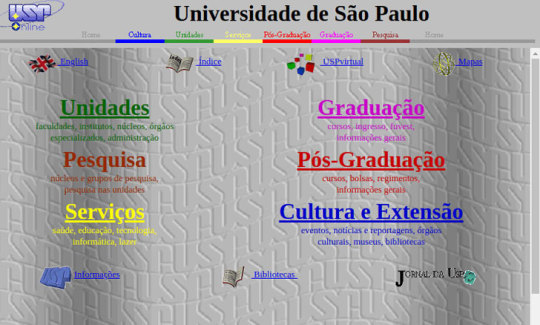
Sim. Esse era o site da USP, em março de 1997. Print: Blog da Informática
Esse jeitão "lo-fi" não era só uma barreira — era um convite. Um terreno bruto e fértil onde artistas mergulharam pra criar, experimentando uma abordagem que escancarava as falhas e os tropeços das interfaces da época.
A Web-Art chacoalhou o boom dos computadores pessoais e sistemas como o Windows 95/98, transformando glitches e bugs em matéria-prima de uma revolução estética.
Influências da Web-Art
A Web-Art se aproveitou das GUIs — essas interfaces gráficas toscas que viraram o playground dos artistas. Eles pegaram estruturas que todo mundo conhecia e subverteram tudo: erros viraram poesia, brechas viraram sátira, e a lógica de navegação dos sistemas foi pro espaço, debochada até o último pixel.

The First Life of Net Art: UBERMORGEN, JODI, Vuk Cosic, Olia Lialina. Imagem: net-art.com
O espírito anárquico do Dadaísmo, aquele movimento de vanguarda nascido em 1916 no meio do caos da Primeira Guerra, pulsava forte na Web-Art. O Dadá era puro grito contra a racionalidade, contra a arte engessada das academias, defendendo o nonsense e a espontaneidade. A Web-Art herdou esse DNA rebelde, rindo na cara da ordem tecnológica.
E tem mais: o ethos punk do "Do It Yourself" — faça você mesmo — foi o combustível pra essa explosão criativa. A partir do uso de ferramentas simples como HTML, Flash e JavaScript, artistas deram vida a obras sem precisar de galerias ou instituições. Bastava uma hospedagem vagabunda na web, e pronto: a Web-Art ganhava o mundo.
Contexto Histórico da Web-Art
A internet dos anos 1990 era um território sem lei, uma "terra de ninguém" digital. Sem as gigantes que hoje ditam as regras, sem padrões rígidos ou censura pesada, os artistas tinham liberdade total pra cutucar o meio. As empresas que dominam a web atual ainda eram embriões — ou nem tinham nascido.
Esse cenário abriu as portas pra uma crítica afiada à tecnologia. A Web-Art jogava na cara a ambivalência do tal "progresso" digital, rindo da ingenuidade que víamos na nova era. Sátiras à usabilidade e às limitações dos sistemas esticavam as falhas até o limite, transformando frustração em surpresa e bugs em arte.

O duo JODI — pseudônimo de Dirk Paesmans e Joan Heemskerk — criava trabalhos que faziam “tudo de errado na Internet que (poderia) ser feito errado” (Baumgartel 167). Nesse trabalho, janelas dançantes faziam parecer que o computador do usuário estava sendo infectado por vírus. Print: Blog Netart2web
Comunidades online brotaram em fóruns como o Rhizome, listas de e-mail como Nettime e chats como mIRC, ICQ e MSN. Era uma colaboração descentralizada, um caldo criativo que conectava artistas do mundo todo, sem chefes ou hierarquias.
A Web-Art não era um Movimento
Por mais que existisse essa troca intensa, a Web-Art nunca foi um movimento estruturado, com manifesto na parede como o Futurismo ou o Surrealismo. Era mais um enxame de expressões — individuais, colaborativas, caóticas —, unidas pela provocação em experimentar o digital e detonar as promessas de inovação dos sistemas.
Ainda assim, nomes como JODI, Alexei Shulgin e Olia Lialina viraram faróis nessa bagunça, trocando ideias em redes informais. Era um fenômeno global, mas fragmentado, com artistas como o brasileiro Fábio Fon trazendo seus contextos locais pra conversar com a cena internacional.
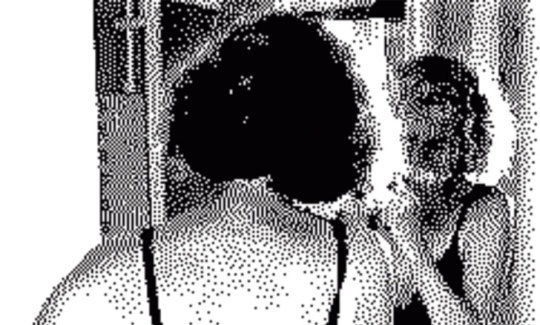
A narrativa poética também fazia parte dos movimentos de Web-Art. A ilustração acima complementa a obra de Annie Abrahams, sob o título Being Human (1997). Print: net-art.org
Ser humano é sobre comunicação com o outro. Essa outra pessoa que você não conhece, mas que deve se parecer com você em algum lugar e, portanto, precisará de alguma garantia de vez em quando também. Pedi às pessoas que tranquilizassem um outro desconhecido. — Annie Abrahams, Being Human (1997)
Estética: O Charme do Caos
A estética da Web-Art dos anos 1990 é puro reflexo daquele tempo. Glitches eram reis: telas azuis de erro, pop-ups absurdos e mensagens que não levavam a lugar nenhum viravam assinatura artística.
A interatividade era errante, quase uma trollagem — sites que te prendiam em loops infinitos ou te jogavam num labirinto de cliques sem sentido. Tudo isso com um visual que hoje podemos chamar de "nostálgico digital": cores berrantes, GIFs tremendo, fontes gritando na tela.
Essa bagunça não era só estilo — era um manifesto vivo. A Web-Art usava o "crude" da tecnologia pra rir dela mesma, pra mostrar que a perfeição prometida pelos sistemas era uma ilusão. E ninguém capturou isso melhor que Fábio Fon com seu "ONOS - On Operating System".
"ONOS": A Web-Art Sarcástica Brasileira
Chegamos ao ápice dessa viagem: o trabalho de Fábio Oliveira Nunes, o Fábio Fon, com o "ONOS", lançado em 1999. Imagine um Windows 95/98 que deu errado — ou, melhor, que deu gloriosamente errado.
O "ONOS" é um sistema operacional fictício, "errante e autorreferente", como o próprio Fon descreve. Feito em Flash, ele imita as janelas e os menus que todo mundo conhecia, mas te joga num pesadelo cômico de erros falsos, loops e interações que zombam da lógica.
No Brasil de 1999, onde a internet ainda engatinhava e o Windows reinava com seus travamentos épicos, o "ONOS" era um soco no estômago. Ganhou terceiro lugar no FILE 2000 em São Paulo e rodou o mundo em exposições como "México Imaginário" (2002). Inspirado por JODI, Fon trouxe o glitch global pra um sabor local, debochando da nossa relação sinuosa com a tecnologia importada.

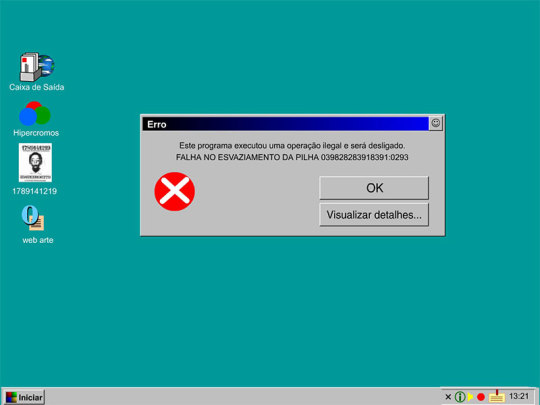
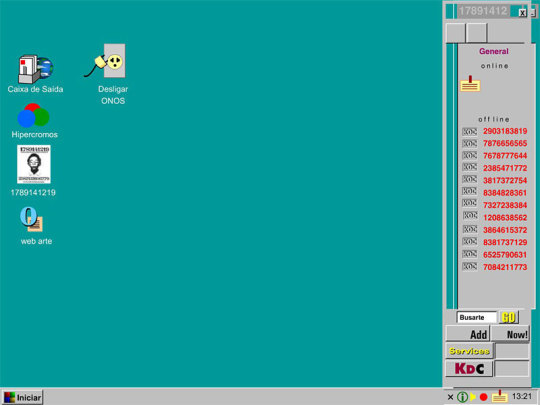


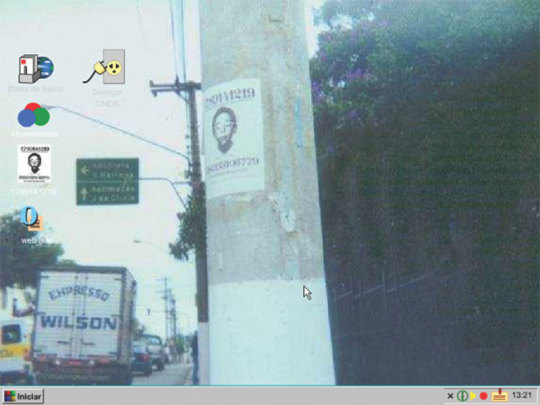
Prints do "ONOS", de Fábio Fon. Imagem: fabiofon.com
O "ONOS" é Web-Art em estado bruto: uma sátira que ri da dependência cega em sistemas e da ilusão de controle. Ele não funciona — e é exatamente por isso que funciona tão bem.
Legado da Web-Art Hoje
A Web-Art dos anos 1990 perdeu o fôlego com a chegada da Web 2.0 e a internet comercializada, mas seu fogo não apagou. Hoje, ela renasce em projetos nostálgicos, como o vaporwave ou os arquivos do Rhizome, e se mistura a novas formas — NFTs, instalações interativas, realidade aumentada.
O Flash perdeu força em 2010 com o HTML 5 e o fim do suporte no iPhone — e morreu de vez em 2020, mas obras como o "ONOS" sobrevivem em emuladores, lembrando a gente do que a web já foi: um espaço livre, bagunçado e vivo.
A Web-Art nos adverte ainda hoje. Ela pergunta: até que ponto a tecnologia que abraçamos sem pensar realmente nos serve? Fábio Fon, JODI e companhia nos deixaram esse legado — um convite pra olhar o digital com desconfiança, humor e um tesão danado por subverter tudo.
Curioso por navegar nas obras de Web-Art? Achei este link que reune várias manifestações. Mas não se assuste! O site net-art é muito fiel à estética "lo-fi" que falamos lá no começo do post!
Quer ver como eram sites de empresas conceituadas, como bancos, provedores e universidades? Achei esse post no Blog da Informática, com imagens interessantes da era jurássica da web!
0 notes
Note
Hey Ada, I miss seeing you around. I was looking at cool web art (Olia Lialina's stuff on her website) and thought of you. Hoping all is well friend :) From Isla
isla!!! sweetest message i could possibly receive :')
i'm not sure if i'd seen lialina's site before but i love it, so so cool. the work "lossless" is really pretty, and i feel like it would be a nice thing to rip off/pirate for home decor.
her books also seem really interesting. hci was what i ended up gravitating to at uni and now i really wanna hear what she has to say about alienation in the field. that topic came up in my final project a bit and i feel like too few programmers interact with it properly.
let's hang out sometime!
3 notes
·
View notes
Text
post internet y era digital
26. Post-Internet y arte digital
Justificación de la actualidad y relevancia del tema
El impacto de Internet y las redes sociales ha transformado profundamente la producción y distribución del arte. El concepto de Post-Internet, acuñado por Marisa Olson y posteriormente desarrollado por Gene McHugh en Post-Internet: Notes on the Internet and Art (2011), describe una práctica artística que no solo utiliza Internet como medio, sino que también responde a su influencia cultural y estética.
Desde el Net Art de los años 90 hasta las nuevas formas de creación digital en plataformas como Instagram, TikTok y NFT, los artistas han explorado cómo la hiperconectividad, la inmaterialidad y la obsolescencia digital han cambiado la manera en que se percibe y experimenta el arte. El Post-Internet no es solo arte hecho en la red, sino arte que refleja la cultura en la que vivimos tras la consolidación de Internet como espacio dominante de interacción.
Texto crítico basado en el marco teórico y conceptual
Autores como Lev Manovich en The Language of New Media (2001) han analizado cómo el lenguaje visual y la estructura del arte digital emergen de la lógica computacional. Por otro lado, Claire Bishop en Radical Museology (2013) discute cómo el arte digital y el Internet han alterado la función del museo y la experiencia del espectador.
Olia Lialina es una pionera del Net Art y ha trabajado con la estética de la web temprana en proyectos como My Boyfriend Came Back from the War (1996), utilizando la fragmentación de la pantalla como un recurso narrativo.
Rafaël Rozendaal crea páginas web como obras de arte, como en www.ifnoyes.com (2005), transformando la navegación en una experiencia estética y proponiendo nuevos modelos de coleccionismo digital.
Jon Rafman explora la cultura de Internet y la memoria digital en obras como 9 Eyes (2009), donde recopila imágenes capturadas por Google Street View, resaltando la automatización de la mirada y la estética del azar en la era digital.
Amalia Ulman investiga la construcción de la identidad en redes sociales. En su performance Excellences & Perfections(2014), creó una narrativa ficticia en Instagram, engañando al público y exponiendo la performatividad del yo en el entorno digital.
Petra Cortright trabaja con la estética de la webcam y los filtros digitales en piezas como VVEBCAM (2007), donde utiliza efectos visuales para cuestionar la autenticidad y la estética de lo amateur en Internet.
Eva & Franco Mattes han trabajado con la apropiación de imágenes en la red y la exploración de los límites entre lo real y lo digital. En Life Sharing (2000-2003), hicieron pública toda su información personal en un sitio web, anticipando los debates sobre privacidad y exposición en Internet.
Conclusión
El arte Post-Internet y digital ha reformulado la manera en que se entiende la creación artística, adaptándose a un entorno donde la conectividad, la imagen digital y la interacción en línea son fundamentales. Artistas como Olia Lialina, Rafaël Rozendaal, Jon Rafman, Amalia Ulman, Petra Cortright y Eva & Franco Mattes han utilizado la lógica de Internet como un medio y un tema central en su obra, explorando las dinámicas de identidad, archivo, vigilancia y estética en la era digital. En un mundo donde lo físico y lo virtual se entrelazan constantemente, el arte digital continúa redefiniendo los límites de la creatividad y la experiencia estética.
0 notes
Text

Olia Lialina, My Boyfriend Came Back from the War, 1996. Photo: Franz Wamhof.
4 notes
·
View notes
Text
This coming Saturday @ gmt+1 5pm / Cest 6pm / Est 12pm online
With
Janna Ahrndt [US]
Janna Ahrndt (She/They) received her MFA in Electronic and Time- Based Art from Purdue University in 2019. Janna is currently a resident of Windham, Maine. Their work explores how deconstructing everyday technologies, or even designing them yourself, can question larger oppressive systems and create a space for participatory action.
The systematic erasure of the GeoCities platform has been a topic of conversation in new media archival circles. Olia Lialina & Dragan Espenschied’s One Terabyte of Kilobyte Age project emphasizes the importance of digital folklore and folk art as part of our history. I look at the collapse of this massive platform as a failed wakeup call to all those who forget their web presence is rented space from large corporations who can remove you or your entire community when it is deemed no longer profitable. As I focus on spaces of mourning and grief on this dead platform, I am also projected into what that means for mourning spaces on new platforms. In a way, all of the internet is built on a graveyard, and there is no way to permanently archive the experience of being on these dead platforms.
By using tears to analog glitch artifacts from these lost pages, I hope to evoke a hauntological perspective on the internet’s past.
For this event, I will describe my work mining the 1 TB of data archived from Geocities for personal memorial pages. This will lead into a participatory conversation with others about their experience with loss and how the internet may positively or negatively impact that experience. Other artists and researchers purposefully avoid using these pages in their display of this archive due to the personal nature of grief and loss. Post-pandemic, I have increasingly become fascinated and more aware of how my mourning and loss rituals have been shaped by digital mediation. This occupation with death, material culture, and the internet has led to the ongoing creation of my artwork, deadWeb Lacrymatory. Through the convergence of glitched media players, a vintage CRT monitor, and a vessel containing human tears and seawater, this project seeks to unravel the layers of cultural and emotional significance embedded in the digital artifacts of the past.
For more information follow the link
0 notes
Text
This coming Saturday 26/10/2024 @ gmt+1 5pm / Cest 6pm / Est 12pm online with Janna Ahrndt discussing ' Archives of Digital Mourning: Deadweb Lacrymatory'
Janna Ahrndt [US] - (She/They) received her MFA in Electronic and Time- Based Art from Purdue University in 2019. Janna is currently a resident of Windham, Maine. Their work explores how deconstructing everyday technologies, or even designing them yourself, can question larger oppressive systems and create a space for participatory action.
The systematic erasure of the GeoCities platform has been a topic of conversation in new media archival circles. Olia Lialina & Dragan Espenschied’s One Terabyte of Kilobyte Age project emphasizes the importance of digital folklore and folk art as part of our history. I look at the collapse of this massive platform as a failed wakeup call to all those who forget their web presence is rented space from large corporations who can remove you or your entire community when it is deemed no longer profitable. As I focus on spaces of mourning and grief on this dead platform, I am also projected into what that means for mourning spaces on new platforms. In a way, all of the internet is built on a graveyard, and there is no way to permanently archive the experience of being on these dead platforms.
By using tears to analog glitch artifacts from these lost pages, I hope to evoke a hauntological perspective on the internet’s past.
For this event, I will describe my work mining the 1 TB of data archived from Geocities for personal memorial pages. This will lead into a participatory conversation with others about their experience with loss and how the internet may positively or negatively impact that experience. Other artists and researchers purposefully avoid using these pages in their display of this archive due to the personal nature of grief and loss. Post-pandemic, I have increasingly become fascinated and more aware of how my mourning and loss rituals have been shaped by digital mediation. This occupation with death, material culture, and the internet has led to the ongoing creation of my artwork, deadWeb Lacrymatory. Through the convergence of glitched media players, a vintage CRT monitor, and a vessel containing human tears and seawater, this project seeks to unravel the layers of cultural and emotional significance embedded in the digital artifacts of the past.
For more information follow the link.
0 notes
Text
Balancing Creativity & Technology
In both bell hooks’ Teaching Critical Thinking and Olia Lialina’s Not Art & Tech, two important people offer their unique perspectives on the relationship between “creative practices” and “critical thinking”. hooks highlights how essential critical thinking is, not just for education but for meaningful creative expression and overall artwork. She believes that questioning the world around us—whether that’s societal norms or structures of power—is a necessary part of creating art that truly resonates and inspires. Thinking outside of the box and also outside of set ideals and exploring every facet of our world is a key aspect that she highlights throughout her writing. For hooks, art isn’t just about aesthetics or self-expression; it’s a way to push boundaries and challenge the so-called “status quo”.
Lialina, on the other hand, delves into the modern art world, particularly this terminology we see quite often, “the intersection of art & technology”. She critiques how new media art can sometimes overuse technology, focus more on the software, and overemphasize the technological aspect, losing sight of the deeper artistic intent of the creators. In her view, technology should be a supportive tool that enhances art, not the main focus, which I wholeheartedly agree with. Still, our society loves to capitalize on the notion of “modernism” and “advancement” across all creation platforms. Lialina’s perspective encourages artists to consider how technology can add substance to their work rather than flash and bling.
Based on both readings, some questions arise about the underlying messages and motivations of artists’ works—what ideas is it engaging with? This underscores the need for critical thinking in the art world. Meanwhile, Lialina encourages us to closely examine the role of technology—does it serve the art, or is it just there for show?
Balancing technological innovation with artistic integrity is extremely tough, as I can speak from personal experience. Our society is so oversaturated with technology that it feels like little things are constantly being invented every day, and there’s no originality simply because of the overuse of technology. I am trying to find a middle ground to counter this feeling, but it undeniably pressures artists to find their “niche” to capitalize on. Though getting swept up in the excitement of the newest tools is easy, both hooks and Lialina suggest that true creative depth comes from reflection and purpose, not just novelty. Critical thinking becomes a guiding force in ensuring that art, no matter how cutting-edge, still has heart and soul.
0 notes
Photo
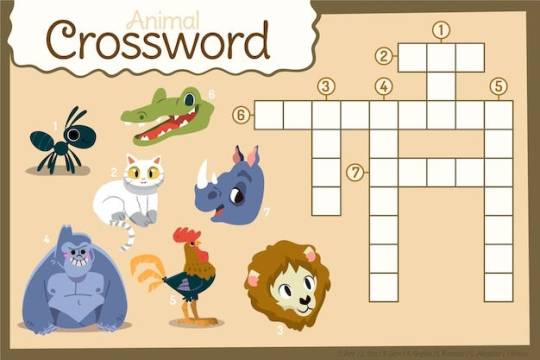
(via Element of Early Internet Art Crossword)
Prominent Early Internet Art Activities
A few noteworthy ventures from the beginning of web craftsmanship keep on being praised for their development and impact:
Olia Lialina’s “My Sweetheart Returned from the Conflict” (1996) This spearheading piece of hypertext fiction utilizes a progression of interactive pictures and text parts to recount a nonlinear story, permitting watchers to explore through various account ways.
(1995) Made by the craftsman couple Joan Heemskerk and Dirk Paesmans, Jodi.org is an assortment of sites that undermine the shows of website composition, giving watchers apparently tumultuous and strange connection points that challenge their assumptions and comprehension of the web.
0 notes
Text
comecei a tomar o fitoterápico de forma consistente pra ansiedade. é difícil dizer se é ele deixando meu corpo mole ou o calor de 39 graus. ficar doente nesse calor foi bem frustrante, mas hoje acordei melhor. no final de semana assisti bottoms com a milena e no hard feelings sozinho. li coisas pra faculdade, li esse texto da olia lialina. momentos bons de silêncio. depois de 2 dias sem passear com a bibe, ontem eu desci de noitinha e sentimos o vento, tava prestes a chover. foi bom.
3 notes
·
View notes